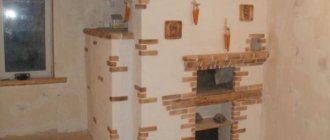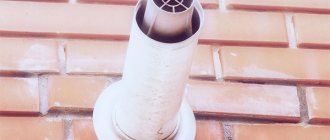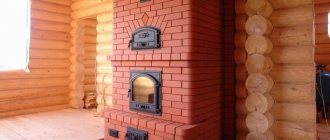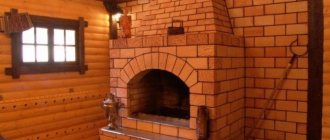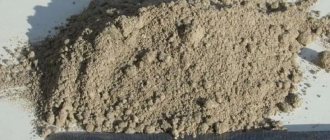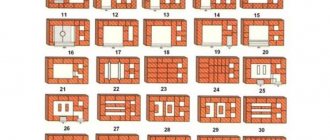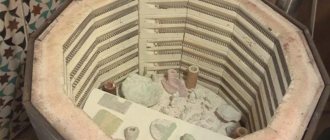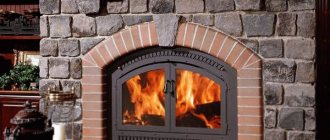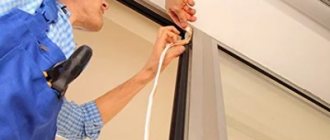For restoration and elimination of defective cracks, a special or personally prepared putty for the stove is used. Professional compositions have good heat resistance, so they will last longer, but will also cost more. But everyone can prepare such a product with their own hands; it will have no less high-quality properties, and will cost less. We propose to consider each of the suitable means for sealing in today's publication.
Covering a brick oven in a house with a special solution Source eco-kotly.ru
How to cover up cracks to make it secure
To eliminate all kinds of holes that have formed during regular operation of the furnace, they try to use reliable compounds that cope with the problem the first time. In this section we will look at some of these tools.
Fireclay clay
Ready-made fireclay clay provides reliable sealing of joints that do not deform under constant exposure to high temperatures. The dried composition is characterized by a high level of vapor permeability and endurance when exposed to wet steam under high pressure.
Deep cracks on a brick wall from a home stove Source pechdoc.ru
The material is also considered environmentally friendly, since it does not emit toxic fumes when heated, and accordingly is harmless to people and animals. In order to prepare such a solution, you will need:
- one part of cement (grade “500”);
- two parts of fireclay clay (can be purchased at a special store);
- seven parts of river sand.
How to plaster a wooden house with clay. Clay plaster
Clay plaster is unique among all other types of plaster for interior and exterior walls. The growing interest in clay plasters has recently been associated with the trend of choosing natural, environmentally friendly materials for finishing. Clay is also used for plastering wet rooms (except for showers and walls that are directly affected by water and moisture), but clay plasters are most widely used for masonry and finishing of fireplaces and stoves. Decorative clay plasters with fillers made of straw, sawdust, and plastic fiber occupy a special place in the decoration of eco-interiors. One of the main advantages of clay as a material for plaster is the absolute naturalness and environmental friendliness of the composition. Red and white clay are more common. Natural clay is a sedimentary rock that does not contain mineral components harmful to human health; in addition, clay plasters are able to adsorb harmful components from the air of the home and bind them, which makes clay walls the best finishing option for people prone to allergies. This beneficial effect for the indoor microclimate is complemented by the ability of clay walls to regulate humidity in the house: a layer of clay easily absorbs excess moisture and just as easily releases it back into the indoor air when the humidity level decreases. A few more benefits of clay finishes:
- Ability to conduct heat;
- Hygroscopicity and the ability to accumulate and release moisture;
- The plastic properties of clays make it possible to plaster surfaces operating under conditions of strong heating and sudden cooling: stoves and fireplaces, chimneys;
- Cost-effective, low prices for materials. Possibility of independently procuring clays of excellent quality. Preparing clay is a fairly long but simple process;
- The hardness of clay is less than that of cement plaster, but is sufficient to protect enclosing structures from both mechanical and thermal influences. Clay is impractical only for exterior plinths, but with reinforcing fiber in combination with lime and other binders it is also used for exterior plasters;
- Clays can be used more than once.
Video description
Plastering a brick oven with your own hands.
Special oven glue is not diluted in large quantities as it tends to harden quickly. After this, it cannot be used a second time, since repeated dilution will cause the composition to lose its strong qualities.
Using special oven glue to seal joints between brick joints in a home oven Source waysi.ru
What tools are needed?
When choosing what to coat the stove with, you need to remember the tools. To repair it yourself you will need:
- angular spatula;
- Master OK;
- chisel;
- sanding paper with grit No. 60 and 100 and a grater for it;
- building level and rule;
- brushes – wide, brushes;
- container where the composition will be mixed.
If clay is added, then you need to prepare a mesh (metal) for wiping it. If you use sand, you will need a mesh to sift it through.
Guide to oven coating: technology to follow
If the question arises of how to coat the stove with clay or any other means to eliminate cracks, it is recommended to follow the algorithm below. It will make it possible to do all the work efficiently the first time and without additional modifications. The process consists of the following steps:
- In the resulting gap, remove any remaining old plaster and all dust. Next, deepen this crack by 1 cm. This way you increase the repair space, which makes the sealing process more convenient. Re-dispose of all waste.
- Coat all prepared areas with water and primer, and then heat the oven so that all the liquid evaporates. Put out the fire, when all the steam has completely disappeared, it should be emanating from the surface of the oven.
- While the walls of the structure are still hot, coat the prepared areas with a clay solution. At this point, it is important not to overdo it and apply a thin layer of oven caulk.
- Afterwards, take a reinforcing mesh or burlap and secure it with small self-tapping screws to the damage so that they completely overlap.
- Next, prepare the grout solution and carefully apply two layers to the defective areas using a spatula.
Leave the structure until completely dry. Remember that lighting a fire in it immediately after caulking in order to dry the seams faster is strictly prohibited. Trying to speed up the process will result in even more cracking. At this stage, the question of how to accurately coat the outside of the stove has been resolved.
Repairing a brick kiln against cracks in the seams Source sdelai-lestnicu.ru
How long will it take to dry?
The oven cannot be used after repair until all applied layers are completely dry. How long this will take depends on the composition used. Heat-resistant glue dries in a matter of hours; the sand-clay mixture will take a day.
Important! Try to plan repairs for the summer, when the furnace is not in use. This will allow enough time for any composition to dry completely.
How to repair a firebox in a brick stove
If the question arises of how to repair cracks in a brick stove inside, you should try to minimize the heating of the walls using additional lining. This process involves the installation of special barrier partitions that absorb the entire thermal shock. The inside of the firebox is lined with one of the following materials:
- Cast iron. This is a fairly reliable type of raw material, it is distinguished by its durability and can withstand both loads and constant high temperatures. When introducing it, be sure to leave a small air gap between it and the brick wall.
- Steel. The material will last less than the previous one, since it tends to burn out quickly. An air cushion must be created behind such a layer. To maintain it at the same distance on all sides, a corrugated layer is laid. It will burn out after the first use of the stove, and the back space will remain free.
- Fireclay brick with markings ША-6 and ШБ-6. These models are not installed tightly to the stationary walls of the furnace. The approximate gap will be 7-10 mm. The brick is laid on fireclay mortar, which has increased stickiness.
Restoration of the firebox and removal of cracks in a brick kiln Source pechdoc.ru
Photo
Below are the best real photos of properly plastered stoves:
Tags: putty for stoves, mortar for the stove to prevent cracking, repair of a brick stove, what to put on the stove
How to seal cracks in a metal stove
You may also need to decide how to cover the cracks in a metal stove, because it gradually burns out, and it is not always easy to allocate funds for repairs. Clay grout can be used as a restoration product. It is important to make a thick enough layer that will prevent combustion products from escaping from the firebox. The clay should be diluted in the traditional way, you can add a small amount of ash from the same oven and mix thoroughly until smooth.
Repairing a metal furnace by welding exfoliated metal fragments Source ipk-rotor.ru
If a hole or crack in the metal appears in the area where the chimney meets the stove chamber itself, then you need to take a small plate of metal, coat it with stove glue and fasten it to the deformed area. Seal the space on top with the same composition. To solve this issue, a reinforcing mesh is also used, which is subsequently plastered.
How to smear clay on walls. Advantages and disadvantages of clay plaster
Clay plaster is considered an environmentally friendly and natural material that has been used in construction since ancient times. The practical use of plaster will provide a beautiful design for the room. Walls plastered with clay will breathe without releasing harmful substances into the air. Moreover, this material is not harmful, unlike other putty solutions made on the basis of polymers and other synthetic substances.
Previously, plastering walls in this way was the only option for finishing work. Despite the fact that modern manufacturers offer a wide selection of different solutions, many buyers still prefer to use natural materials. Plastering a house with clay has many advantages, which will be described below:
- Eco-friendly and natural product.
- Clay mortar is capable of absorbing moisture, which will prevent walls from collapsing.
- Low cost of materials compared to other types of products.
- After using the solution, there is practically no waste left, and the remaining clay can be reused.
- Ease of preparation of the mixture.
- Clay for plastering walls will protect the surface from mechanical and other influences.
- The material is elastic in its structure.
- Clay can be used for finishing work indoors and for the facade.
- Technologies for applying clay will allow you to create an original decorative pattern on the walls, and adding paint will create a certain shade.
Clay plastering has its drawbacks, which are determined by the following parameters:
1. Natural clay, which does not have various additives, is a unique material that requires experience to work with. When preparing a solution, the main thing is to correctly calculate all the components, because there is no specific recipe for making the mixture.
2. Plastering the facade of a house is not an easy task. It is important to consider that clay absorbs all moisture well, which is why small cracks appear from time to time around the perimeter of the building. Thus, clay walls will need to be renewed every year.
3. Recently, there are not many craftsmen who would professionally plaster walls with clay, and therefore paying workers can be expensive.
Most hardware stores offer a wide range of products, and on the shelves you can see decorative clay, as well as mixtures of different shades and variations. The physical and other characteristics of the clay are usually indicated on the packaging, and manufacturers also provide short instructions for use. In fact, it is not necessary to purchase clay in its natural form, because you can buy a prepared mixture, which will make the work process easier for a beginner.
It is important to know! If you decide to choose natural clay for your summer cottage or other places, you need to remember that using the material without special additives can cause the plaster to crack when exposed to moisture or active sunlight.
Types of cracks and features of their repair
Having figured out how to coat a brick stove when deformations appear, you need to familiarize yourself with the types of cracks that appear. Conventionally, they are divided into cobwebs and other types. The first type of cracks is classified as non-through, and therefore their treatment is much easier. To seal a sealed surface in this way, you need to follow a step-by-step algorithm:
- clean the surface and use a chisel to remove excess plaster and debris that is stuck in the cracks;
- then clean the surface nearby with a metal brush, sweep away excess dust;
- treat the prepared surface with a primer so that it penetrates into the cracks;
- mix cement with water until the consistency of liquid sour cream is formed, take a brush and treat the damaged areas with it.
Go over the cracks several times to ensure the damage is completely filled. Otherwise they will appear again very soon.
Plastering the stove with clay. Types of mortar for plastering stove walls
The stove is one of the building elements that regularly heats up and cools down, so the chosen plaster composition must be resistant to this phenomenon.
Mixtures for preparing plaster mortar are divided into two types:
- Simple compositions that include only two components, sand and clay.
- Complex formulations contain more than two ingredients.
Plastering a stove with clay and sand requires preliminary preparation and cleaning of the materials from various impurities. In particular, sand must be sifted through a fine sieve, clay should be rubbed through a fine mesh to remove roots and small stones.
It is recommended to make the plaster mixture using fatty types of clay, this promotes better adhesion of the solution to the surface. If the clay is too oily, the amount of sand used can be increased.
You need to know how to dilute clay for plastering a stove. To begin with, it should be soaked in a small amount of water and left for several hours, adding liquid in small portions if necessary. The process is repeated until a 10-15 cm layer of water remains above the clay. After mixing the finished clay mixture, the consistency of thick sour cream should be obtained.
In some cases, asbestos, finely chopped straw or fiberglass are added to the mixture for plastering the stove. These reinforcing components make it possible to obtain more durable materials.
When preparing plaster mixtures, special attention must be paid to the environmental side. During the heating process, the materials used should not emit substances that pose a danger to human health and life.
Separately, it should be said about salt; it is also sometimes added to the solution for plastering the stove. It should be noted that the opinion that salt makes it stronger can be considered erroneous. In fact, salt increases the hygroscopicity of clay, making it more flexible and resistant to cracking. Also, a plastering solution, to which a certain amount of salt is added, prevents the proliferation of various insects in masonry joints. For owners of private houses, this fact is of great importance.
Another component that can be added to the plaster mixture is gypsum powder. This material is used as a fixative. However, plaster must be used very carefully, as it hardens very quickly. The initial setting of the solution with the addition of gypsum powder occurs immediately after application, and after 10-15 minutes the surface hardens completely.
Adding lime along with gypsum makes the solution more durable and able to dry in a short time. But when choosing such mixtures, you should remember the properties of gypsum, so it is better to prepare a small portion immediately before plastering the stove. It is very important to understand that it is impossible to dilute the gypsum mixture with water.
Video description
Oven for frying. How to put terracotta on glue.
On a note! In order not to make a mistake with the choice of grout, it is better to use ordinary clay, but first it should be checked for fat content. They do it this way: take five parts of clay and mix each of them with sand in different proportions, diluting with water. Then they make a bun from each mixture and throw it on the ground. The one that crashed is the fattest. Accordingly, the composition is ideal for sealing furnaces.
Where is the best place to use the mixture?
Clay building mixtures are necessary when the structure is exposed to different temperatures. Also, their plastic properties are in demand when decorating premises. Both materials are actively used in the manufacture of pottery, but here the mixture used is different.
For masonry and repair of stoves - proportions
The ratio of components is chosen taking into account how much the part of the furnace structure heats up:
- Clay mortar is used in the construction of a heat-storing area. It heats up to 550–600 C, does not come into contact with flame, and is not exposed to oxides. The fluff and the source of the chimney also do not heat up very much - up to 400 C, although they cool more strongly. The proportions are determined by the plasticity index: from 2 to 5 parts of sand per 1 part of clay.
- Fireclay solution can be heated to 1200 C and higher. It is needed for laying the combustion chamber. In some cases, the entire stove or fireplace is made of fireclay. The usual ratio is 30% clay and 70% fireclay. But if the clay mixture is oily, the proportions change - 50:50.
- Rows 1 and 2 of the stove can be placed on a lime-sand option.
- Cement is not elastic and breaks down under high heat. Mixtures based on it are only suitable for the foundation and chimney cap.
It is possible to replace the fireclay mortar with a cement-fireclay mixture. It is only slightly inferior to fireclay in terms of fire resistance, but it sets very quickly. After preparing the solution, it must be used within 45 minutes.
For plaster - ratio of materials
For finishing work, white and red clay of different fat contents are used. Only the cleanest sand is taken - river, sea, alluvial quarry, fine or medium fraction. The ratio is standard: for high fat content 1:5, for medium fat content – 1:3, for lean fat content – 1:2. Read about the differences between quarry and river.
The characteristics are selected in accordance with the purpose of the plaster composition. To level the wall and fill defects, you need plaster that fills the unevenness well and sets quickly. It is preferable to take quarry or artificial sand: its grains have an angular shape, are rough and adhere better to the binder component. For decorative finishing, river wood is chosen: its particles have a rounded shape and are more evenly distributed throughout the volume of the material.
For sandblasting work
For sandblasting, only sand or slag is used. The best choice is loose yellow or white quartz. Different jobs require different fractions:
- Dust-like – with grain sizes up to 0.1 mm. They process fragile surfaces in order to create a matte background or pattern.
- Average – 0.1–0.4 mm. This is how complex images are obtained on glass and mirrors with varying degrees of dullness.
- A relatively large fraction with particles up to 1 mm is used to obtain three-dimensional images.
For construction work
Materials are the basis of almost all building mixtures and artificial materials. Red brick is made by firing clay, mortar and concrete contain either sand or kaolin minerals, and the finishing always includes one of the materials. Read about the technical conditions for quicklime lump lime in this article.
The laying mixture is selected based on the properties of the material and the nature of the work. Silicate stone is placed on cement mortar, and red stone is placed on clay-sand mortar. The reason is the correspondence of thermal and strength characteristics.
Methods
Water purification from clay suspension takes place at the first stages of water treatment. Methods and forms of purification, as well as the types of equipment used, will depend on the initial quality of the water based on its analysis data. The more water is contaminated with clay, the more stages of purification it goes through.
So, purifying water from clay includes:
- settling is the initial stage of water treatment, allowing large and heavy clay particles to settle to the bottom;
- the use of a hydrocyclone is a method of purifying water from mechanical impurities that do not settle; operates on the principle of a centrifuge, when large particles are concentrated near the walls of the device, and purified water is collected in the central part;
- filtering is a method of purifying water by passing it through a special membrane, the pores of which are smaller than the particles of pollution that are captured;
- filtration through clarifier filters - the action is similar to filtering;
- coagulation - adding special substances to water that promote the enlargement of suspended particles, which can subsequently be removed by filtration;
- film filtration is a method in which the filter material is covered with a film of clay suspension, including even very small particles.
Each of the listed methods is usually used in combination with others, since they all represent stages of one process.
Specifications
Clay-based plaster has very good thermal insulation characteristics. In terms of this property, the mixture is somewhat worse than only clay-sawdust coating. The thermal conductivity of the first is 29 W/(m K). If we compare this characteristic with cement-sand mortar, for clay this indicator is 1.5 times lower.
A fairly important property is also vapor permeability. Since moisture must leave the premises, this characteristic is valued in finishing materials. In this case, it varies from 0.11 to 0.15 mg/(m h Pa). This value in this case is even greater than that of a log, so the composition is also applicable for wooden buildings.
When choosing such a composition, it is also important to take into account the density. This characteristic denotes the ratio of mass to volume. In this case, it is equal to 1700 kg/m3. This indicator is characteristic of brick. To calculate the required amount of material, you need to know its consumption. The material can be laid on walls 1 cm thick. Then about 15 kg will be needed for each square meter.
Fireclay sand
Fireclay sand should have fractions of 0 15 - 5 mm. Fireclay crushed stone should have fractions of 5 - 20 mm.
Fireclay sand is also produced by crushing broken fireclay bricks.
Fireclay filler 50 - 60%; This is the so-called fireclay sand with a maximum grain size of up to 5 mm.
Portland cement concrete (per 1 m3 of concrete): Portland cement - 300 kg, chamotte crushed stone - 700 kg, chamotte sand - 700 - 500 kg, finely ground chamotte - 100 - 300 kg, Portland cement - 250 kg, chromite crushed stone - 1200 kg, chromite sand - 850 kg, finely ground chromite - 750 kg.
To repair the linings of trolleys, heat-resistant concrete on liquid glass with sodium fluoride of the following composition is used: liquid glass (specific gravity 1 38) 400 kg, sodium fluoride 50 kg, finely ground chamotte 500 kg, chamotte sand 500 kg and chamotte crushed stone 750 kg. Concrete hardens within 24 hours and does not require moisture.
Concrete on alumina cement (per 1 m3 of concrete): alumina cement - 300 kg, chromite crushed stone - 1200 kg, chromite sand - 1200 kg, alumina cement - 300 kg, chamotte crushed stone - 750 kg, chamotte sand - 750 kg.
Concrete on liquid glass (per 1 m3 of concrete): liquid glass - 300 - 350 kg, chromite crushed stone - 1300 kg, chromite sand - 800 kg, finely ground chromite - 650 kg, liquid glass - 300 - 350 kg, fireclay crushed stone - 750 kg , fireclay sand - 500 kg, finely ground fireclay - 500 kg, liquid glass - 360 kg, expanded clay - 640 kg, finely ground fireclay - 640 kg, liquid glass - 500 kg, expanded vermiculite - 300 kg, finely ground fireclay - 100 kg.
Heat-resistant concrete is prepared from soluble glass with a density of 1 38 - 1 40, sodium silicofluoride, fine and coarse refractory aggregate. Consumption of individual components per 1 m3 of concrete designed for service at temperatures up to 1100 C: soluble glass with a density of 1 38 350 - 400 kg, Na2SiFe 40 - 50 kg, finely ground fireclay 500 kg, fireclay sand 500 kg and crushed fireclay 750 kg. When used as a finely ground additive and crushed magnesite brick fillers, the resulting concrete can last up to 1400 C. Heating refractory concrete to 500 C does not reduce their strength; in the temperature range 600 - 900 C, the strength of most concrete decreases slightly and at higher temperatures increases and often exceeds the strength of the original concrete.
Heat-resistant concrete is prepared from soluble glass with a density of 1 38 - 1 40, sodium silicofluoride, fine and coarse refractory aggregate. Consumption of individual components per 1 m of concrete designed for service at temperatures up to 1100 C: soluble glass with a density of 1 38 350 - 400 kg, Na2SiF6 40 - 50 kg, finely ground fireclay 500 kg, fireclay sand 500 kg and crushed fireclay 750 kg. When used as a finely ground additive and crushed magnesite brick fillers, the resulting concrete can last up to 1400 C. Heating refractory concrete to 500 C does not reduce their strength; in the temperature range 600 - 900 C, the strength of most concrete decreases slightly and at higher temperatures increases and often exceeds the strength of the original concrete.
The ceiling is made of lightweight lining. Thus, vertical combustion screens have the possibility of free thermal expansion upward. A layer of roofing material is laid on top of the combustion screen collectors and ceiling screen pipes to prevent adhesion of the pipe part and fastenings to the concrete. Then a solution of refractory concrete is poured (composition: fireclay sand and crushed stone, aluminous cement) in accordance with the drawings.
Goals
If you plan to use water in everyday life, especially for drinking and cooking, cleaning it from clay is necessary. It allows:
- reduce turbidity - even in small concentrations, clay suspension reduces the transparency of water and makes it unsuitable for drinking;
- soften water and remove impurities from it - water containing dissolved clay, in terms of hardness, as a rule, does not meet the requirements of GOST “Drinking Water”, and is also often unsuitable for domestic needs;
- eliminate odor - drinking water, according to regulatory documents, should not have any foreign odors.
- disinfect water at the initial stage of purification, since clay suspension often contains dangerous microorganisms, algae, protozoa and other biological objects.
Drying masonry
Typically, clay masonry takes quite a long time to dry, because brick is a porous material that absorbs moisture and releases it weakly. Typically, oven drying is carried out in two stages:
- The first stage is natural drying. It lasts up to 5-7 days. The damper, all doors and the vent in the stove must be open. To speed up the process somewhat, you can turn on the fan and direct it to the mouth of the firebox. At this stage, the upper layers of the solution harden.
- The second stage is forced drying. Duration - up to 10 days in summer and up to 4 weeks in winter. Several small logs are burned in the stove twice a day. When, 3-4 hours after the completion of the firebox, condensation does not form inside the door, the stage will be considered completed.
Clay is an ideal material for making stove masonry. It is 100% environmentally friendly, inexpensive and can be applied without special knowledge and skills. Due to its many positive properties, clay is used everywhere and will not lose its relevance in the future.
Removing Impurities
Almost all quarry clays and sands contain impurities and require purification. Remains of plants, roots, grains of sand, pebbles, and pieces of crushed stone are removed from raw materials in various ways.
How to remove impurities from clay
Impurities greatly degrade the quality of the masonry. Purification of raw materials is carried out in three stages:
- manual sampling of plant remains, roots, crushed stone, pebbles;
- sifting through a metal sieve with a hole size of 1.5 mm;
- soaking clay;
- rubbing through a metal fine-mesh sieve.
Photo 2. The process of sifting clay through a metal sieve. You need to press it with your palm so that all the particles pass through the mesh evenly.
In practice, to clean clay for mortar, craftsmen do without the labor-intensive process of soaking the raw materials.
How to remove impurities from sand
The sand is considered prepared when the water passing through it becomes clear. To prepare the material, you need to do the following:
- Plant remains, roots, and large stones are manually selected from the sand.
- After a rough sampling, the material is sifted through a metal sieve with a mesh size of 1.5 mm.
- The sand is placed in a burlap bag (or net) and washed with running water. A hose is used for flushing; water is supplied under pressure.
